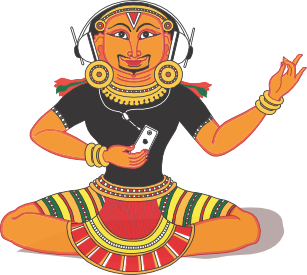
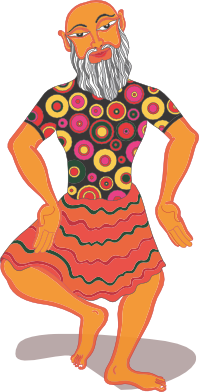
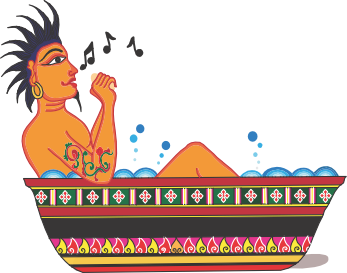
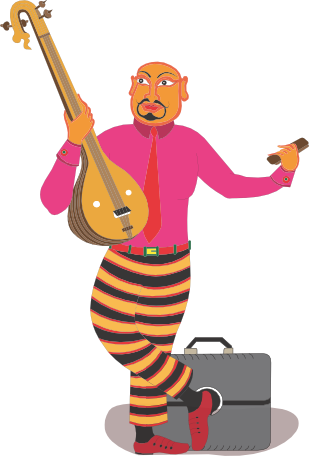
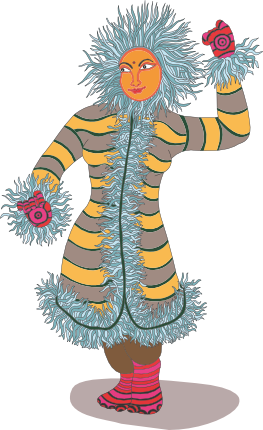
Posted by admin in Dance
on Jul 19th, 2012 | 0 comments
Kathakaḷi
Kathakaḷi is a classical dance form of India that originates from Keraḷa, the south-western part of India. It is a unique form of dance with a marvellous combination of elaborate gestures, picturesque costumes, grand make up and vigorous music. Kathakaḷi is a group presentation in which dancers take on various roles to present stories from Hindu mythology like the Rāmāyaṇa and the Mahābhāratha.

History: Kathakaḷi was derived from the ‘Chākiār Kūthu’, the earliest known art form of Keraḷa. Kathakaḷi had its birth in the 15th century. It is an improved version of Krishnanāttam, a kind of dance drama composed by Mānavadhévan Rājā, the ruler of Calicut in 1657 AD. Raja Vīra Keraḷa Varma, King of Kottārakara was the first to compose Kathakaḷi. He once requested Mānavadhévan to send his troupe of Kriṣhṇanāṭṭam dancers to perform for a royal wedding in his palace. This was turned down and Mānavadhévan added an insult by sarcastically commenting that the scholars down south were not capable of appreciating artistic and literary performances such as Kriṣhṇanāṭṭam. Out of sheer indignation the Rājā of Kottārakara designed a new type of dance called Rāmanāṭṭam dealing with the story of Rāma. This new style of dance developed and grew. The next man to contribute to its development was the Rājā of Kōṭṭayam who based his themes on the Mahābhāratha. He composed four Kathakaḷi plays, namely Bakha Vadham, Kālakeya Vadham, Krimira Vadham and Kalyāṇa Soungandhikam. This was further developed by the great Kārthika Thirunāḷ Maharājā of Travancore who composed seven plays namely, Subadhrā Haraṇam, Narakāsura Vadham, Gandharva Vijayam, Rājasūyam, Bakha Vadham, Pānchāli Swayamvaram and Kalyāṇa Sougandhikam. Similarly numerous contributions have been made by the scholars from the royal family of Travancore.
Kathakaḷi was fortunate to enjoy the patronization of the rulers of Kerala until mid 19thCentury. It received a severe setback when people began to consider the art form indecent. Credit goes to the great poet Mahākavi Vallathōl Narāyaṇa Menon for resuscitating Kathakaḷi. He established the Keraḷa Kalā Maṇḍalam, a center for arts and culture in 1930 with the aim to re-establish art forms like Kathakaḷi and Mōhiniāṭṭam.
Makeup: Makeup in Kathakaḷi is elaborate and complex. The makeup artist is called the chuṭṭikāran. He takes at least three hours for this make up. The primary colours used for makeup are red, green, yellow, black and white. The nature of each character is reflected through the colours of their faces. For example, green reflects virtue, black shows evil, red shows ambition and ferocity, yellow reflects passiveness and white shows spirituality.



Costumes: A massive and intricate headgear is the most important part of Kathakaḷi costume. The headgear is prepared from light weight wood. It is embellished with mirrors, colourful stones and pieces of shiny metal plates. Loads of jewellery including anklets, bracelets, big rings and a huge chin cap complete the semblance of a Kathakaḷi dancer. Evil characters sport talons (big claw like nails) and beards to depict their beastly nature. All principal characters wear long sleeved jackets which are tied at the back. The lower part of the costume is a white skirt with a coloured border. Layers of skirts of vivid colours are also worn for buoyancy. Generally, women do not participate in Kathakaḷi. Men act as women. The female characters wear long sleeved white jackets, long skirts and a long cloth over their heads. The ornaments they wear include a large girdle with beautiful patterns for the waist, a white scarf around the neck, artificial hair, ankle bells and silver clips attached to the fingers.
Compiled by: Aarthi Natarajan & Indira Kadambi




